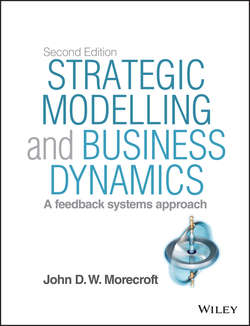Читать книгу Strategic Modelling and Business Dynamics - Morecroft John D. - Страница 17
На сайте Литреса книга снята с продажи.
CHAPTER 1
The Appeal and Power of Strategic Modelling
A New Approach to Modelling
ОглавлениеWorld Dynamics and Limits to Growth anticipated a new and participative approach to modelling and simulation. People's ability to manage their complex world can be improved by visualising and simulating it. Plans and alternative futures become clearer by rehearsing them (O'Brien and Dyson, 2007). Only now is this approach coming to be widely appreciated in business, political and academic circles. During the 1970s, models were still viewed as instruments for accurate prediction whose validity rested primarily on short-term predictive power, conformance with established economic theory and goodness-of-fit to historical data. Modelling for learning, of the kind presented in this book and intended to complement people's mental models, was in its infancy.
The idea of rehearsing alternative futures is fundamental to contemporary strategic modelling and scenario development. The purpose of models and simulations is to prepare organisations and individuals for alternative futures by bringing these futures to life so they are imagined more vividly than would otherwise be possible. Moreover, as you will see throughout the book, strategic models not only help people to generate alternative futures for their firms and industries, but also to challenge, shape, change and enrich their interpretation of a complex world.
An important objective for modellers (and arguably for anyone in a leadership position who has to make sense of complex business or social situations, devise strategies and communicate them) is to find a compact ‘shareable’ description of how a firm, industry or social system operates. Sooner or later, the creative and divergent thoughts that are present at a very early stage of enquiry (captured in the phrase ‘there's a lot going on out there’) must be turned to convergent thoughts that focus group attention on the essence of the situation at hand (by agreeing, through ruthless pruning, what's really important and what can be safely ignored). In business dynamics, this creative process of simplification (known as ‘conceptualisation’) takes shape as a picture of a firm or industry that the modeller agrees with the project team. There are of course guidelines to follow. You begin by identifying so called stock accumulations and feedback loops, the visual building blocks of system dynamics models and simulators. Striking the right balance of creativity and convergence is an essential art of modelling. The parsimonious structure of the World Dynamics model is evidence of creativity and disciplined convergence in model conceptualisation. The model's enduring appeal and power to communicate lies partly in its concise yet compelling representation of a massively complex reality.9
9
Modelling can be controversial. World Dynamics was and still is a thought-provoking model, a potent catalyst for political debate and an instrument for serious policy making. It was also a focus of learned criticism about the nature and use of modelling and simulation in the social sciences. Quotations from the press and academic literature at the time convey the impact, both positive and negative, of the model on opinion leaders: ‘This is likely to be one of the most important documents of our age …’, New York Times; ‘There are too many assumptions that are not founded, and there is too high a level of aggregation in the model’, Science; ‘This year will not see the publication of a more important book than Forrester's World Dynamics, or a book more certain to arouse dislike’, Fortune; ‘This is a piece of irresponsible nonsense, a publicity stunt … extremely simplistic, given the current state of knowledge in the social sciences’, economists from Yale. Notice the sharp division of opinion on the scope, size, adequacy and usefulness of the model. The serious press thinks the work is important for its readers and worthy of policymakers' attention. Academics question the model's apparent simplicity. Not surprisingly judgements vary about the complexity and accuracy required of models (or even ideas and theories) for them to offer useful guidance to business and society. Modellers need to strike a careful balance.
